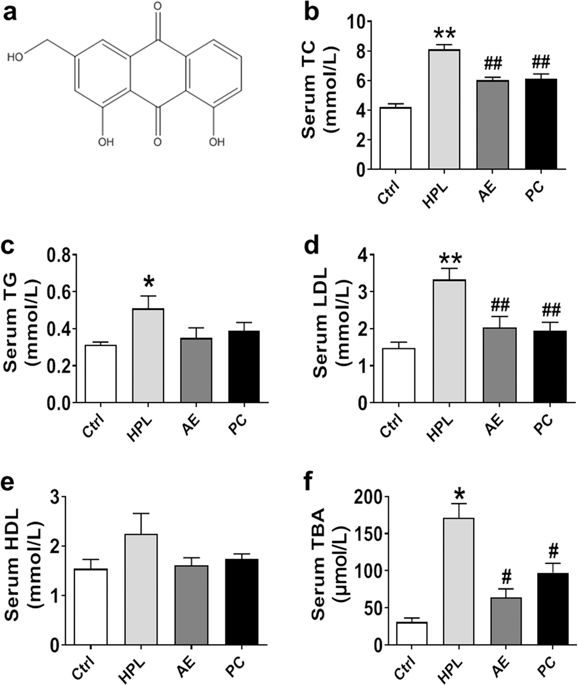Acta Pharmacologica Sinica ( IF 6.9 ) Pub Date : 2020-03-18 , DOI: 10.1038/s41401-020-0392-8 Zhen-Li Su 1 , Peng-Zhou Hang 1, 2 , Juan Hu 1 , Yu-Yang Zheng 1 , Han-Qi Sun 1 , Jing Guo 1 , Ke-Yu Liu 1 , Zhi-Min Du 1, 2, 3

|
Hyperlipidemia (HPL) characterized by metabolic disorder of lipids and cholesterol is one of the important risk factors for cardiovascular diseases. Proprotein convertase subtilisin/kexin type 9 (PCSK9) is a potent circulating regulator of LDL through its ability to induce degradation of the low-density lipoprotein cholesterol receptor (LDLR) in the lysosome of hepatocytes. Aloe-emodin (AE) is one of potentially bioactive components of Chinese traditional medicine Daming capsule. In this study we evaluated the HPL-lowering efficacy of AE in both in vivo and in vitro HPL models. High-fat diet-induced rats were treated with AE (100 mg/kg per day, ig) for 6 weeks. We found that AE administration significantly decreased the levels of total cholesterol (TC) and LDL in the serum and liver tissues. Moreover, AE administration ameliorated HPL-induced hepatic lipid aggregation. But AE administration did not significantly inhibit HMG-CoA reductase activity in the liver of HPL rats. A cellular model of HPL was established in human hepatoma (HepG2) cells treated with cholesterol (20 μg/mL) and 25-hydroxycholesterol (2 μg/mL), which exhibited markedly elevated cholesterol levels. The increased cholesterol levels could be reversed by subsequent treatment with AE (30 μM). In both the in vivo and in vitro HPL models, we revealed that AE selectively suppressed the sterol-regulatory element-binding protein-2 (SREBP-2) and hepatocyte nuclear factor (HNF)1α-mediated PCSK9 signaling, which in turn upregulated LDL receptor (LDLR) and promoted LDL uptake. This study demonstrates that AE reduces cholesterol content in HPL rats by inhibiting the hepatic PCSK9/LDLR pathway.
中文翻译:

芦荟大黄素通过抑制高脂血症大鼠的前蛋白转化酶枯草杆菌蛋白酶/ kexin 9型发挥胆固醇降低的作用。
以脂质和胆固醇的代谢紊乱为特征的高脂血症(HPL)是心血管疾病的重要危险因素之一。前蛋白转化酶枯草杆菌蛋白酶/ kexin型9(PCSK9)是LDL的有效循环调节剂,具有诱导肝细胞溶酶体中低密度脂蛋白胆固醇受体(LDLR)降解的能力。芦荟大黄素(AE)是中药大明胶囊的潜在生物活性成分之一。在这项研究中,我们评估了体内和体外HPL模型中AE降低HPL的功效。高脂饮食诱导的大鼠接受AE(每天100 mg / kg,ig)治疗6周。我们发现,AE的使用显着降低了血清和肝组织中总胆固醇(TC)和LDL的水平。此外,AE给药改善了HPL诱导的肝脂质聚集。但是,AE注射并没有明显抑制HPL大鼠肝脏中的HMG-CoA还原酶活性。在用胆固醇(20μg/ mL)和25-羟基胆固醇(2μg/ mL)处理的人肝癌细胞(HepG2)细胞中建立了HPL细胞模型,其胆固醇水平显着升高。胆固醇水平升高可以通过随后用AE(30μM)治疗来逆转。在体内和体外HPL模型中,我们发现AE选择性抑制了固醇调节元件结合蛋白2(SREBP-2)和肝细胞核因子(HNF)1α介导的PCSK9信号传导,进而上调了LDL受体(LDLR)和促进LDL摄取。









































 京公网安备 11010802027423号
京公网安备 11010802027423号